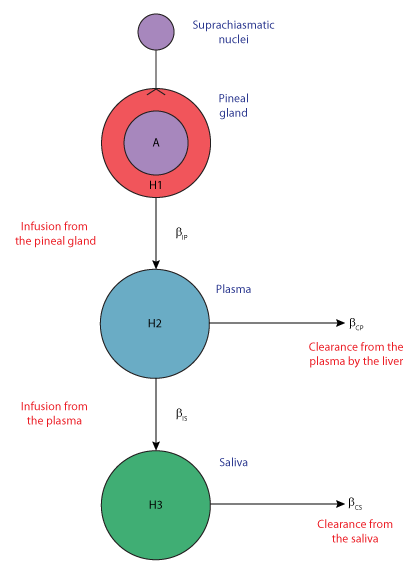St Hilaire, Gronfier, Zeitzer, Klerman, 2007
Model Status
This CellML version of the model has been checked in COR and PCEnv. Currently it runs in PCEnv but it does not recreate the published results. Once the model author loads the original model onto their website (found here) we'll check the CellML code against this original version and will hopefully be able to fix the CellML model.
Model Structure
Since it is impossible to directly measure the activity of the circadian pacemaker in humans, alternative markers of the circadian rhythms must be used, such as plasma melatonin, core body temperature and cortisol levels. Of these markers, it has been demonstrated that plasma melatonin is the most reliable, and its presence in both blood and saliva makes it more accessible for assay. Furthermore, unlike cortisol melatonin is relatively unaffected by sleep-wake state.
Several mathematical models of circadian rhythms have been developed based on plasma melatonin data. These employ a number of different methods to estimate circadian phase and amplitude from the measured melatonin data. However, the accuracy of these methods comes into question since melatonin levels can be subject to inter-individual variation and can also be influenced by environmental factors - especially light. Furthermore, the underlying physiology of melatonin secretion and clearance is often ignored.
In the study described here, Melissa St Hilaire et al. address these issues by developing a physiologically based mathematical model of melatonin, including ocular light suppression and interactions with the circadian pacemaker. Their model is an extension of the previously published model of melatonin rhythms by Brown et al. (also described in CellML). A saliva component has been added, and the effect of light on melatonin levels has been incorporated into the model by including equations based on those published by Kronauer et al..
 |
| Schematic diagram of the components and variables in a mathematical model of human melatonin. Melatonin is synthesised in the pineal gland where its precursor tryptophan is converted to serotonin, and then to melatonin. The rate determining step in this synthesis pathway is the governed by the activity of N-acetylserotonin (NAT) (here represented by A), and the activity of this enzyme is controlled by the suprachiasmatic nuclei of the hypothalamus, the main mammalian circadian pacemaker. Melatonin is not stored in the pineal gland. Once synthesised melatonin diffuses into the systemic circulatory system. From the plasma it is absorbed by various tissues and partially bind with albumin to be subsequently cleared by the liver. In addition, some melatonin infuses from the plasma into the saliva, from which it can also be cleared. |
The complete original paper reference is cited below:
A physiologically based mathematical model of melatonin including ocular light suppression and interactions with the circadian pacemaker, Melissa A. St Hilaire, Claude Gronfier, Jamie M. Zeitzer, and Elizabeth B. Klerman, 2007, Journal of Pineal Research , 43, 294-304. (Full text and PDF versions of the article are available to journal subscribers on the Journal of Pineal Research website.) PubMed ID: 17803528

